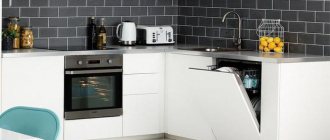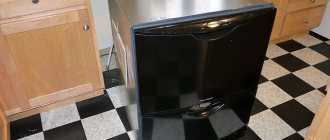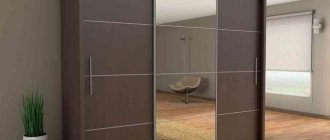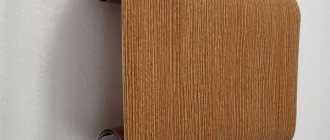If you bought a built-in dishwasher, then you now face several difficult tasks. You have probably already become acquainted with some of them earlier, when installing a washing machine. Indeed, in many ways these household devices are similar - the same connection to the drain, connection to the electrical network. However, a new task appears before you - fastening, installing the facade to the dishwasher. Many people think that this is an activity for furniture assemblers; however, installing a facade with your own hands is not difficult. In this article we will tell you what can be useful for carrying out such work.
At what stage should the façade be attached?
To install a dishwasher façade, you need to understand the installation steps. The key part of the job is connecting the device to the sewer pipe, electricity and water supply. Work on the design of the front side is carried out at the last stage, after solving the main tasks.
Many users are interested in whether it is possible to start the machine if the front part has not yet been installed. According to experts, it is better to postpone this until installation is completed. Without reliable protection, the device will not be able to perform basic functions, and its operation will be accompanied by strong heat generation and noise.
Often the façade arrangement is carried out at the beginning of the installation work, and the connection with communications is postponed until last. This option is permitted only in case of delays due to a parallel change of the riser in the toilet or laying a new power line. In order not to waste time, users decorate.
Connection to water supply
The water supply is connected to cold water. It is advisable to install a filter on the water, which will reduce its hardness. This will significantly extend the life of the device.
If you do not pay due attention to the quality of the water, the machine will quickly fail. The check valve in the device will break
This will cause even cleanly washed dishes to smell unpleasant.
How to properly connect a dishwasher
To prevent the check valve from malfunctioning, water filters are installed.
In addition, the water supply is connected only to cold water. It is not advisable to connect it to hot water, because the quality of such water does not meet the necessary requirements.
Stages of connecting the water supply:
- turning off the water - usually the tap is located in the kitchen;
- disconnecting the hose from the mixer;
- a tee is screwed onto the pipe and connected to the mixer;
- A ball valve is connected to the tee (in the middle branch). The latter has an outlet to which a hose from the dishwasher is already connected;
- a filter is installed on the outlet to retain debris.
Water supply connection
The dishwasher usually comes with a short hose. It may not be enough to connect to the pipe. In this case, it is recommended to purchase a longer hose. You should not try to build up the old one - this will be a very unreliable solution.
Connecting the dishwasher to the water supply
Instructions for connecting to the water supply
As a rule, flexible hoses from pipes with hot and cold water go to the mixer tap located in the sink. That is why the most convenient way to connect the PMM is located in the place where such a hose is connected to the water main. Otherwise, you will have to make a tap into the pipe using a tee or a manifold with two bends and taps. When connecting a flexible hose to a water supply, a tee with a shut-off valve must be installed under the sink.
A shut-off valve in the tee is necessary so that you can quickly stop the water supply in case of an emergency. Since most PMM models only require cold water, one tee will be required.
For work, you should prepare the following tools and materials:
- a tee with a built-in faucet, made of brass or bronze, with a thread diameter of 3/4 inch (this diameter is suitable in most cases);
- inlet coarse filter (if one is not included in the dishwasher kit);
- fluoroplastic sealing tape (FUM tape);
- adjustable wrenches;
- sharp knife.
If the kitchen already has a washing machine or plans to install one, the tee should be replaced with a manifold with two outlets with the same diameter (3/4 inch) and two shut-off valves (see photo above). In addition, some PMM models are equipped with inlet hoses that are too short, a little more than a meter long. If this length is not enough, you will have to buy a new hose from a specialized store.
To properly connect the dishwasher to the water supply with your own hands, the work should be done step by step, in several stages:
- Shut off the water supply to the apartment.
- Disconnect the flexible hose supplying cold water to the faucet from the water supply pipe.
- Connect the water pipe to the inlet of the tee or splitter by first winding FUM tape onto the thread.
- Connect the outlet of the tee or manifold to a flexible hose going to the mixer. Don't forget to use FUM tape.
- Connect the filter and dishwasher inlet hose to one of the side outlets.
- If you have a washing machine, connect its inlet hose to the second outlet of the splitter.
- Check the tightness of all connections by supplying water to the main line.
This completes the connection of the dishwasher to the water.
Sometimes the situation does not allow installing a PMM near the sink. In this case, you have to crash into the water pipe. If it is made of metal-plastic, there will be no difficulties. It is necessary to cut out a piece of pipe and install a tee or manifold with press fittings in its place to ensure a reliable connection.
There is no need to cut the metal pipe - just put a clamp with an outlet on top and drill a hole in the pipe through the outlet. This connection is also reliable.
Preparation of tools and materials
To properly attach the front of a built-in dishwasher, you need to use several tools that are available in every home workshop. These include:
In the absence of electrical appliances, you can get by with a screwdriver. With its help you will need to install self-tapping screws in the previously made holes.
The upcoming work will be simplified if a stencil for the lining is included with the dishwasher. It uses paper with marked points for holes.
The workpiece is fixed on the back side of the finishing structure, after which marks for fasteners are placed on it. In addition to the basic tools, you need to use related available tools, including double-sided tape. It is necessary at the preparatory and fitting stage, when it is important to choose the exact location of the facade.
To achieve a better connection between the doors and the decorative surface, the heads of the screws are sealed into the structure.
Installing a façade structure using a blank requires less time than installing a home-made product. In the second case, you need to use additional carpentry tools:
Preparatory activities
Experts recommend that before attaching the facade panel, preparatory work is carried out, during which the necessary materials and tools are prepared.
Tool
To perform installation work, you will need special working tools, among which are the following:
- Screwdrivers. These are common tools that are found in almost every home. Most often they are used if it is necessary to screw in screws and screws. Screwdrivers may differ in purpose and size. The choice of suitable models depends on the type of fastenings used.
- Roulette. When carrying out installation work, it is necessary to take various measurements. For this, a tape measure is used, with which you can take measurements.
- Screwdriver. This is a hand-held electric tool that is often used for driving and unscrewing self-tapping screws, screws and screws. You can also use it to drill holes into which fasteners will be installed in the future.
- Marker or pencil. They will be needed to mark the places where the mounting holes will be drilled.
- Awl. This tool is used if you need to pierce holes in fragile surfaces. It is recommended to use a strong awl to prevent it from breaking during the piercing process.
Materials
To install the facade you will not need as many materials as tools. Among the most important materials are:
- Stencil. This is a very important detail that can help when installing the facade. With its help, the places where the mounting screws will be installed are marked. To use a stencil, you need to attach it to the panel and mark the places for fastenings.
- Scotch. For installation work, it is recommended to use double-sided tape. You will need it to attach the façade to the surface before screwing in the screws.
Installation instructions
Before installing the front on the dishwasher, you should prepare the listed tools and available materials, and also carefully study the instructions for the upcoming work.
Determining the dimensions of the decorative panel
To determine the dimensions of the facade, it is not necessary to perform complex calculations or create diagrams. This nuance is already provided by the manufacturer, and the instructions for the dishwasher include the required values (width, thickness, length, allowances).
In most cases, the width of the panel corresponds to the width of the device, because... the side door has the parameters of the body. For a standard 60 cm model you will need 598 mm. A 45 cm dishwasher front will have a width of 448 mm.
As for the height, it may differ depending on the placement of the facades of adjacent cabinets.
The use of surfaces with increased length is permitted if this is provided for in the design project. In this case, it is important to make sure that the remaining part does not interfere with the opening of the doors.
Provided that the panel is in contact with the base, it is better not to touch it, but cut off the edges of the base, following the contour.
Choosing the right fixation method
Before attaching the trim parts to the built-in dishwasher, you must select the appropriate mounting method. This stage requires compliance with basic rules and recommendations. If you act in your own way, this can lead to the fact that over time the facade will fall off or “move” to the side.
When using nails instead of self-tapping screws, the possibility of various troubles during the dismantling stage cannot be ruled out. Expensive devices have a long service life and often last longer than a wooden set.
To change the lining, you will need to tear out the nails, which is accompanied by the risk of deforming the door.
Fixing the façade of a built-in dishwasher using glue is not allowed. The surface of the panel installed in this way will fall off due to the loss of properties of the adhesive composition due to temperature fluctuations or, conversely, will harden.
It is also unwise to use glue as a retainer - the panel will quickly fall off under its own weight or any mechanical influences.
We carry out the installation sequentially
When installing the door for the Electrolux PMM, it is important to make sure that the unit is placed level. Any tilt is not allowed and risks incorrect fixation of the panel.
After completing the fastening, all that remains is to check for gaps and backlash. Any such defects must be corrected.
After finishing decorating the front part, it is important to secure the body on the sides. To do this, just remove the top tank under the dishes, find the holes and secure the screws there.
To prevent common mistakes, you should follow these expert recommendations:
When using an old cabinet door as a front trim, at the fitting stage you will need to familiarize yourself with the location of the fastening points. It is important to ensure that they do not coincide with the new holes. Otherwise, the screws will pop out and the panel will partially come off.
To simplify the work ahead, prepare for possible nuances and perform everything in the best possible way, it won’t hurt to watch training videos with a detailed overview of each stage.
Source
Sizes - how to choose the right one
The size of the facade is calculated in accordance with the dimensions of the dishwasher. Typical models of household appliances are characterized by the following parameters:
Often the manufacturer indicates rounded values in the passport, so it would be useful to take measurements yourself.
The front part is always 1-2 cm larger than the front panel of the dishwashing unit, and it is also necessary to provide a reserve for installing fasteners.
To ensure that the height of the panel matches the countertop, adjust the position of the dishwasher legs. In the case of partially built-in equipment, the dimensions of the control panel are also included in the calculations.
If, after all the manipulations, the façade for the built-in dishwasher rests against the plinth when opening, then a small gap is made in it. It is equal to the thickness of the decorative panel plus 2-3 mm.
Preparation of tools and materials
To attach the cover you will need:
Dishwasher facade stencil
Several pieces of double tape are needed to try on the facade. Experts do not recommend immediately fixing the panel with self-tapping screws. The work will be done in vain even with an error of 2-3 mm. For an extremely tight connection between the surface of the facade and the door, the heads of the screws are driven as deeply as possible into the canvas. It is easier to secure a ready-made workpiece than a self-made product. In order to do it yourself, you will need carpentry tools and sandpaper, which will have to be used to sand the product. Then it must be impregnated with an antiseptic composition, then the entire surface or only the ends should be painted.
What does the locking mechanism consist of?
First, let's look at the internal structure of the PMM to make it easier to determine the breakdown.
The locking mechanism is located inside the door and consists of the following elements:
- metal spring;
- cable (metal or fabric);
- plastic locking element;
- loops.
Some models, such as Bosch, also have closers that make the door move smoother.
The mechanism of operation of this system is simple. You open the dishwasher and thereby set the hinges in motion. This increases the tension of the cable, and it, after itself, stretches the spring. When the spring is stretched to its maximum, the locking element falls into a special hole and fixes the structure, preventing the spring from closing. At this moment, the PMM can safely be in the open position. As soon as you want to close it and move the door up, the lock will come out of the grooves and allow the spring to slam the door.
That is why PMMs that are not equipped with closers should be held when closing. If this is not done, the door will slam loudly and there will be a jerk that can damage the internal mechanisms or the housing.
Basic installation details
To avoid having to install it again, you need to carefully select the façade . An incorrectly selected product will need to be adjusted to the required size or purchased a new one. Be sure to check that the fasteners are marked correctly, otherwise the doors will not close properly. When installing, use a ruler or tape measure, but do not do it approximately, only then can you determine the mounting locations with an accuracy of up to mm. The screws should be of such length that the panels and doors are securely fastened, but so that they do not stick out. To make the correct markings, use a stencil.
It is necessary to take into account the fastenings of the handles that are needed to open the facade panel. They are installed at the same level with the fittings of adjacent cabinets.
Manufacturers produce different types of PMM. The built-in dishwasher is especially popular; many people are interested in how to attach the façade to it.
Possible errors and problems
There are several possible problems that people may encounter during the installation of façade panels. These include the following:
- Choosing the wrong façade. Some people initially choose the wrong panel, which is not suitable for the dishwasher. In this case, you will have to independently adjust the dimensions for the dishwasher or buy a new façade.
- Incorrect marking of mounting holes. There are times when people make mistakes in the process of marking places for future fastenings. This causes the dishwasher door with the panel attached to be difficult to open and close.
At what stage should the façade be attached?
Before placing the car, prepare a place for it. If this is not done, a number of problems may arise. This point is important not only for those dishwashers that are to be built-in, but also for conventional stationary models.
In the installation of any PMM model, including Beko, Bosch (Bosch), Electrolux ESL LA, ESL LO, Zanussi, Ariston, Siemens, Electrolux, the main thing is to connect the equipment to:
The front side is mainly decorated after all work is completed . It is not worth putting the device into operation before the installation is completed. The panel additionally muffles the sounds made by a running dishwasher and also acts as a heat insulator.
Connection features
So, step-by-step instructions on how to connect a dishwasher in stages:
- If you are installing a built-in PMM, then first you need to prepare a niche, which, as a rule, should be 60 cm wide, and for narrow models 45 cm. You can level the machine with the level of the cabinets by removing the tabletop and adjusting the legs of the lower cabinets. You also need to drill holes in the cabinet body for the drainage hose, water intake hose, and electrical wires.
- Installing a dishwasher under the hob is prohibited;
- The installation location is selected so that the length of the drainage hose does not exceed 1.5 meters. An increase in length up to 5 meters is allowed, but stable operation of the equipment in this case will be difficult to guarantee.
- The next step is connecting to electricity. Please note that the socket must be of the Euro type. You need to replace the socket if it does not meet the standards (but not the plug of the machine). Do not forget that we ensure safety when connecting, and the dishwasher has significant energy consumption. This determines the ban on the use of tees and extension cords. Installing a socket involves using a wire with a diameter of more than 2 mm. In addition, a 16A circuit breaker is additionally installed in the electrical panel. Grounding is also carried out using a 3-core wire, and it cannot be connected to pipes.
- Next is connecting the dishwasher to the water supply. To do this, the water is shut off, a tee is connected to the pipe, then a filter, a ball valve and a hen. All threaded joints are insulated with foam - it must be wound in at least 10 layers.
It is also necessary to install a coarse filter, as it will prevent sand and rust from the water pipe from getting inside the machine.
- As for connecting equipment to the sewer system, you can go the simple route by installing a siphon with an additional outlet and valve. In order to protect the device from water entering from the sewer pipe, you need to place the drain hose in a special way - at the point of exit into the sewer network, it is placed at a height of 600 mm along the wall, and then bent to ensure water flow.
- The final stage in connecting a dishwasher is checking the device for functionality. In this case, the machine is tested idle, controlling the rate of water flow, its heating, and operation in drying mode. The test is carried out without dishes, but with the obligatory addition of regenerating salt and detergents.
DIY façade installation instructions
After preparing the necessary tools, they proceed to installation. First, determine the dimensions of the decorative panel. The instructions included with the façade panel kit indicate:
You must adhere to the mounting method recommended by the manufacturer . Otherwise, the fasteners will move to the side over time or even fall off. The panel should only be attached with self-tapping screws; if you use nails, problems will arise during disassembly. If you need to replace the trim with a panel from new furniture, you will need to pull out the nails. This may damage the door surface.
Before hanging the facade, check whether the device is installed evenly in relation to the countertop and adjacent cabinets . If the dishwasher is tilted, the panel will be fixed askew. Then check again whether the width and length of the overlay are accurately adjusted. Afterwards the installation of the facade begins. When closing the dishwasher door, there should not be large gaps.
After the front side is decorated, the side fastenings of the body are made. To fix them, first take out the upper basket for loading dishes and find the mounting holes. Then screw the screws from the side of the washing chamber into the side walls. Fasteners must be the correct length.
Types of fastening
Installation of the façade depends on the installation method of the dishwasher.
There are two options for attaching the decorative panel.
The hinged structure ensures uniform load distribution. However, such a device is complex, requires synchronization settings, and there is a gap between the facades.
A tight fit guarantees the absence of cracks that serve as places for dust, dirt, and condensation to accumulate. In addition, installing the facade directly on the dishwasher door is easier to implement.
What materials are facades made of?
Chipboard is considered the most affordable in terms of cost . But this material has a number of disadvantages, the most important one being its short service life. panels quickly deform . When integrity is compromised, hazardous substances are released.
Very rarely do they choose natural wood , because the material is expensive and requires special care. For decoration, a thin layer of wood called veneer is often used. This façade gives the structure a solid appearance.
Thanks to the decorative coating, it is possible to hide the structure. Once the surface is finally processed, it is impossible to guess that there is a dishwasher behind it. It looks like an ordinary kitchen cabinet.
If you choose the right fittings and use different decorative elements, you can emphasize the originality of furniture accessories and give the surface a finished look. Before installing the front on the dishwasher, you can watch the video. Be sure to follow all recommendations. If you strictly follow the advice, the decorative panel can be installed in a short time, without spending a lot of effort.
Source
Installing a front on a dishwasher: useful tips + installation instructions
The difference between installing a built-in dishwasher and a freestanding model is that additional design is required for the front wall - the machine door.
It is assumed that the decorative panel is selected to match the surrounding interior, and then the facade is installed on the dishwasher.
If experienced craftsmen cope with this operation quickly, then for beginners the task seems quite difficult. To understand the features of facade installation, you should carefully study the instructions and become familiar with some of the installation nuances. And we will tell you about all this in detail in our article.
How to calculate the width of the facade
In order for the product to look neat and attractive, the dimensions of the facade should be slightly larger than the dimensions of the equipment. But on sale there are panels of standard sizes with a width of 45 to 60 cm and a height of up to 82. Therefore, before you start purchasing, measure the unit you have at home, and, based on its parameters, choose the panels required in size.
Since the facade itself is an independent product, it will be almost impossible to adjust it at home, since the design feature and integrity of the decorative element will be compromised.
In order for the facade to fit evenly to the countertop, you will have to adjust the height of the dishwasher legs.
But what are the sizes of 45 cm built-in dishwashers and how they are installed is detailed here.
Design features of built-in PMMs
The range of models integrated into kitchen units is much wider than their free-standing counterparts. This is explained by the principles of ergonomics and space saving inherent in the concept of constructing a kitchen interior. To get acquainted with the best brands specializing in the manufacture of built-in PMM models, please follow this link.
To install a built-in dishwasher, you will need a separate cabinet, or rather, a niche in the set. It differs from a regular kitchen cabinet in that it does not have a back wall or bottom.
The machine is installed directly on the floor, on 3 or 4 support legs. The absence of a rear wall allows for free placement of the water supply and drain hoses.
The cabinet must have reliable walls to which the dishwasher body is attached, and a “roof” - the countertop. The front panel is not fixed to the walls, like conventional cabinets, but directly to the car door.
There is no need to experiment with fasteners : manufacturers have provided installation features and prepared special holes for self-tapping screws. We have provided detailed instructions for installing a built-in dishwasher model here.
What is a facade for PMM? This is a decorative panel, most often made of the same material as the front surface of the entire kitchen unit. It is made from MDF, plastic, laminated chipboard, solid wood or combined materials.
Where do you get decorative panels?
There are several ways to make it:
The first method is considered the most practical: when ordering, all dimensions of the car are taken into account, so the facade “fits” perfectly. But this method is not always applicable. We recommend that you familiarize yourself with the options for integrating a dishwasher into a finished kitchen.
Overview of species
As has already become obvious, the front of a dishwasher is a decorative panel that is installed on the front of the device, usually on the door. Conventionally, facades can be divided according to several criteria.
Dimensions . Facades must be selected according to the dimensions of the device itself. Standard machine sizes can be 450-600 mm in width and 800-850 mm in length. There are also unique models with excellent dimensions. Ideally, the facade should be slightly larger than the outside of the car, but this is not always possible. The bottom edge of the front should be at the same level as the rest of the kitchen, and the top edge should end 2-3 cm from the countertop.
Material of manufacture . Often panels are made from MDF and laminated chipboard. Chipboard models are cheap, but not entirely safe - when heated, they can emit harmful fumes. Plastic and solid wood can also serve as raw materials. A rare case is the use of combined materials. For example, made of glass and wood or wood and metal. Models made only from wood are the most expensive and rare. The reason is quite banal - in order for the wooden facade not to deform under the influence of temperature, high-quality surface treatment is required. The finishing of not only wooden, but also other panels can include enamel coating, various metals, glass, plastic, wood.
Installation method. At the moment, there are three main methods of installing the panel - conventional, sliding and sliding. When using the first method, the panel is installed in a classic way - the facade is attached directly to the dishwasher door. With the second method, the facade moves upward parallel to the door when the door is opened. In this case, the facade is also attached to the door. The sliding front is only partially installed on the device door. When the dishwasher is opened, the protective panel will also move upward and be positioned parallel to the surface of the door. The last two options are used if you do not want to greatly deform the surface of the device.
At what stage should the façade be attached?
The dishwasher is installed in several stages. The main connection is considered to be connection to communications: water supply, sewerage system, dedicated power line.
Decorating the front side is usually done at the very end, when the rest of the work has already been completed.
Is it possible to run the dishwasher without the decorative trim installed? It is not recommended to launch before installation work is completed for several reasons.
Only a dishwasher that is completely closed on all sides can fully perform its functions; in addition, the panel plays the role of an additional sound and heat insulator.
Sometimes they mask the machine first and then make the connection. This option is appropriate if there is a delay in connection for objective reasons, for example, at the same time the riser in the toilet is being replaced or a new power line is being laid.
In order not to waste time, decorate slowly.
Preliminary work before installation of PMM
There are two options for installing a dishwasher: yourself and with the help of specialists. In the first case, you risk connecting the car incorrectly; in the second, you will have to part with part of the family budget.
Sometimes the skills of one craftsman are not enough; you have to call a team of specialists: a furniture assembler, a plumber and an electrician.
Installation services for built-in equipment are offered by companies that sell them. For a certain fee, a universal master comes at the appointed time, carries out all the connection work and checks the serviceability of the machine.
However, if you carefully study the installation instructions, think about connecting hoses, find or install an additional outlet, you can save money and acquire new skills by doing everything yourself.
Choosing a location based on size
An important step is choosing a location for installation. For the built-in model, furniture modules of the first level are suitable, that is, cabinets standing on the floor.
But if you like a compact mini-dishwasher, then its installation is a little easier - such equipment can be inserted at waist or chest level (for ease of maintenance).
There are several conditions for choosing a good location. If they are not followed, you may later encounter problems with water supply/discharge or PMM maintenance.
Image gallery
Photo from
The furniture module adjacent to the washing unit is the most suitable place, since the water supply and drainage units are located nearby, so it is easy to connect the hoses. The length of the hoses should not be long, otherwise the supply and drainage of fluid becomes difficult, which often leads to breakdowns
Prudent owners, even at the stage of interior planning or renovation, think about installing several grounded outlets for powerful household units. If there is no free power point, you will have to draw an additional line
The machine must be placed freely inside the furniture module, with a margin of 5 cm on each side - more precise information is provided in the instructions. The cabinet walls must be strong and able to withstand the fastening elements and the weight of the dishwasher. Rear wall not provided
You should not expect that the machine will be installed once and for all. Sooner or later you will need to replace parts, reconnect hoses or clean some elements. Therefore, the installation is carried out in such a way that possible dismantling is easy and access to communications is open.
Built-in dishwasher next to the sink
Separate grounded socket for dishwasher
Suitable cabinet for dishwasher dimensions
Dishwasher Maintenance
Many installation difficulties arise when a dishwasher is integrated into an already installed kitchen set. You have to adjust cabinets to fit, and sometimes dismantle and remodel some of the furniture.
We recommend that you take care of the installation location before purchasing furniture. This also applies to other household appliances that require integration. Usually, the models you like are first selected, and when drawing up a sketch of the headset, their location and exact dimensions are taken into account. We have provided recommendations for choosing a built-in dishwasher in this material.
Preparation of tools and materials
Manufacturers of built-in PMMs sometimes list in the instructions what tools may be useful during the installation process. However, they expect that preliminary work has already been done.
If measures are required to lay a power line or tap into a pipe, the list of necessary items will increase.
To be on the safe side and save time, you should stock up on the following tools:
- hammer drill or powerful drill;
- adjustable wrench;
- hammer;
- a set of screwdrivers, including flat and Phillips;
- chisel;
- pliers;
- laser level;
- tape measure, square, pencil;
- screwdriver
In addition to tools, you will need connection parts. It is not recommended to use used elements - this will reduce their service life.
To install a socket, you need to buy the electrical installation product itself, a socket box for it, a three-core copper cable, and an additional automatic protective device.
There are special requirements for the socket: it must be of a “European” type, with grounding, preferably protected from moisture, fully operational, without damage
To connect water, you will need a metal tee for inserting into the water supply system, fum tape, a tap for shutting off water, rubber gaskets, clamps or ties for fastenings.
If the siphon is not provided for connecting another drain hose, then it will also have to be changed.
If the voltage in the network often fails, we recommend purchasing a stabilizer. It can be installed on several devices at once.
Preparation of tools and materials
No special tools are required to secure the façade trim.
The same items that are used to install the dishwasher as a whole will be useful:
If you don’t have a power tool, then one screwdriver is enough - you can screw in the screws by hand if the holes for them are pre-drilled.
The work is simplified by the presence of a stencil for the façade overlay included in the delivery set. It is a large sheet of thin paper with marked attachment points.
The stencil is placed on the back side of the decorative panel and the places where the screws are screwed in are marked.
In addition to the tools, you will need double tape. Several “Velcro” pieces of tape will come in handy when you need to try on the facade. It is not recommended to immediately “mount” it on screws, since an error of 2-3 millimeters will mean all the work is in vain.
To ensure that the surfaces of the door and facade adjoin as tightly as possible, the heads of the screws should be recessed into the canvas.
It is easier to attach the workpiece than a homemade overlay. If you make the panel yourself, you may need carpentry tools, sandpaper for sanding, antiseptic impregnation and paint to finish the entire surface or just the ends.
Mounting methods
It is no secret that fixing the panel is very important; special attention must be paid to it.
There are two ways to attach the facade.
Partial fastening . In this case, the panel covers the main part of the door, while the control panel remains visible.
Full installation. The dishwasher door is completely covered by a panel.
The most common fastening is using self-tapping screws. They are screwed in from the inside. It is necessary to choose the correct length of screws. This way you can avoid seeing the screw heads on the outside of the panel. Another common fastening is hinges. They can be purchased complete with the facade. They are attached near the bottom edge of the dishwasher.
It is strictly forbidden to attach the facade to any kind of glue. During operation, the dishwasher door can either heat up or cool down, depending on the dishwashing mode. Due to such differences, the glue may lose its properties and, as a result, the panel will fall off. It is also possible that the glue will firmly stick the panel to the device door, which is also inconvenient. If dismantling is necessary, it will be impossible to peel off the panel. Another mistake is to glue the panel with tape. This fastening is not enough to hold the panel. While the machine is operating, the facade may simply fall off.
DIY façade installation instructions
Having chosen the right time and prepared the tools, you can begin installation. However, during the installation process they often encounter unpleasant nuances that can delay the installation of the facade indefinitely.
Let's consider installation features that are best taken into account before starting work.
Stage #1 - determine the dimensions of the decorative panel
To find out the exact dimensions of the facade panel, you do not need to make calculations or draw diagrams - the manufacturer did everything for us. The instructions indicate all the indicators of interest - length, width, thickness, allowances.
The width of the panel often matches the width of the dishwasher, since the door on the sides follows the parameters of the body. For example, for standard 60-centimeter models it is usually 598 mm, for 45-centimeter models – 448 mm (there are exceptions).
However, the height may vary. This depends on how the front of the adjacent kitchen cabinets is positioned.
It is allowed to use a panel a few mm longer than the recommended length if the interior requires it. The main thing is that the extra millimeters do not interfere with opening the door at a right angle.
If the overlay touches the base, then it is left unchanged, and the edge of the base is cut out along the contour of the facade.
Stage #2 - choose the right fixation method
It is prohibited to ignore the manufacturer’s recommendations and experiment with methods of attaching the lining. If you fix the facade in your own way, it may fall off or “move” to the side over time.
If you use nails instead of self-tapping screws, you will definitely have problems with dismantling. Expensive appliances last for decades and can “outlive” your kitchen set.
To replace the trim with a panel from new furniture, you will have to rip out the nails with the risk of deforming the surface of the door.
It is a mistake to fix the facade with glue . Two extremes can occur: either the glue will quickly lose its properties due to temperature changes, or it will “tightly” fix the pad to the machine. Both options are impractical.
Leaving pieces of adhesive tape as fastenings is also frivolous - the panel will fall off under its own weight at the very first vibrations of the unit.
Stage #3 - perform the installation sequentially
Before you begin hanging the front, you need to check how level the dishwasher is installed relative to the adjacent cabinets and countertop. An inclined position may result in the panel being secured crookedly.
The second point concerns the sizes - you should check again whether the length and width of the overlay are accurately adjusted. If everything is good, you can start.
If, when closing the PMM door, no large gaps or backlashes are formed, tighten the fasteners, and the work can be considered complete.
After decorating the front side of the dishwasher, do not forget to make the side fastenings of the body.
To fix the side fastenings, you must first remove the upper basket for loading dishes, and then find the mounting holes and screw screws that are suitable in length from the side of the washing chamber into the side walls.
How to choose?
Professionals give some tips on how to choose the right decorative panel for your dishwasher.
As already mentioned, the most important thing when choosing is the dimensions of the dishwasher. There will be no need to select the front yourself if you purchase or order it complete with a dishwasher. The seller will already know the dimensions of the future panel.
You can use an old cabinet door as a facade In this case, it will be important to compare the old holes with those that will need to be made to install the panel. If they coincide, then it is better to abandon such a facade, as this will lead to it being poorly attached. If everything is in order, then you can begin installation.
If you are making a custom panel, you can use the diagram provided by the device manufacturer. All dimensions will be indicated there. The standard width is 45-60 cm, the height can reach up to 82 cm. However, the dimensions may not always be indicated correctly (the manufacturer often rounds them up). You need to measure the dimensions of the device door yourself. The thickness of the facade should not be more than 2 cm. This value is considered the most convenient and sufficient for the panel to perform its functions.
Professional installation advice
To avoid the most common mistakes, we suggest using recommendations from experienced furniture makers:
If a former cabinet door is used as a dishwasher front, when trying it on, pay attention to the location of the old holes.
It is important to ensure that the old mounting holes do not come into contact with the new ones, otherwise the screws may pop out and the panel may partially come off.
After completion of all installation work, you can begin operating the equipment. But first, it is advisable to carefully study the rules of operation and maintenance of the dishwasher.
Conclusions and useful video on the topic
Video instructions help not only to imagine, but also to see the installation process in detail. We offer several examples of self-installation of a dishwasher façade.
Sequence of actions in the video with useful comments:
Installation of a panel from an IKEA set:
Testing of the installed facade:
Installing a decorative panel to disguise a dishwasher is a simple procedure that does not require special skills. However, you need to act very carefully and skillfully, otherwise you can ruin the lining .
If you are not confident in your abilities, invite an experienced furniture maker to install it - he will cope with the installation work in 15 minutes.
Have you completed the façade installation yourself and want to share your success with other users? Share your experience in the comments to this article and the difficulties you encountered. Also add a photo of the finished work.
Source
Front for dishwashers - what is it?
The facade for a dishwasher is a decorative panel that hides its body. It has not only an aesthetic, but also a practical purpose.
The advantages of similar designs include:
- the ability to hide equipment that does not fit into the overall interior design;
- performing protective functions to protect the housing from aggressive influences such as high temperatures, humidity and greasy contaminants;
- the façade covers the control panel from small children who may press buttons out of curiosity;
- providing additional sound insulation.
Basics of installation and model selection
There are three main types of dishwashers:
If free-standing machines are placed anywhere in the kitchen, then other types of PMM “Electrolux”, “Ikea”, “Gorenye” and other brands are built into the furniture set. Initially, decide on the installation location and prepare a niche for the dishwasher. How to connect the PMM correctly, read one of the previous articles.
The advantage of the built-in PMM model is that it is completely hidden behind the door, being part of the interior.
The decorative panel can be screwed to the door, hiding the equipment from prying eyes. Most often, the wall part is made of the same material as the rest of the kitchen: for example, Leroy MDF.
A template for mounting a decorative facade is supplied complete with built-in models from Siemens, Beko, Miele. Depending on the type of installation, the front panel may be attached before the door is attached to the dishwasher.
Facade purposes
The facade of the dishwasher is a decorative panel element made from furniture materials. The main purpose of the facade is to hide the dishwasher in the kitchen furniture, making it part of the kitchen interior.
- Facade purposes
- Dishwasher front size
- Self-installation of facades
Dishwashers that are fully built-in are usually 450mm or 650mm deep. The hanging facade of such devices has the following advantages:
- there is no need to select the appropriate color of the machine; it fits perfectly into the interior, since it is a common part of the kitchen;
- the control panel buttons are almost invisible, children will not press them randomly;
- has soundproofing properties, the sound of the dishwasher is not so audible.
Dishwasher panels are made from a finely dispersed fraction; this is a medium-density wood fiber board. The thickness of the board is usually standard 16 mm (furniture thickness) and is covered with a film that completely replicates the texture, texture and color of the furniture.
In some dishwasher models, the open door can only be locked after the appliance plate is installed.
Door and front dimensions. Canopy and mount
The dimensions of the decorative panel depend on the size of the dishwasher. This can be narrow - 45-60 cm, full-size - from 60 cm or compact equipment - height 50-60 cm.
It is advisable to decide on the choice of machine, and then order a kitchen with a prepared niche.
What to do if the dishwasher front is too long? You won't be able to cut it, as you will ruin the appearance of the set, because it is laminated on top and covered with decorative film.
If the front is slightly larger than the door, adjust the legs of the appliance so that it fits perfectly under the countertop.
What you will need for work:
Attached is a full-size template drawing, screws, self-adhesive tape, and fastenings. You can figure out how to secure the panel by following the instructions. For an experienced master this will take no more than 10-15 minutes.
Types of facades, functions
The facade for PMM is decorative cladding that harmonizes with kitchen furniture. Attaches to the car door. MDF panels are practical and durable. They can be laminated, covered with colored film, attached with original fittings and various decorative elements. Hanging chipboard or PVC is a big risk. These materials are easily deformed by vibration, high temperature, and moisture.
Sheathing functions:
- Simplifying the choice of technology. You don’t have to worry about the color of the case, but focus on the technical characteristics, since the dishwasher won’t be visible anyway.
- Child protection. A car hidden behind the door will not become a “victim” of children's curiosity.
- Noise isolation. An additional panel absorbs noise. German built-in models, such as Siemens, Bosch, Miele, Hansa, are equipped with special noise-absorbing gaskets that are inserted between the door and the front panel.
Types of fastenings
The casing can be attached to the door with self-tapping screws (option for fully built-in models), or secured on hinges (for partially built-in models). Slider mounts are often used in Gorenje, Ikea, Electrolux, and Beko modifications.
Sheathing dimensions
Depends on the dimensions of the PMM. The standard width of the machine is 60 cm (full size), 45 cm (narrow). The common height is 82 cm. Dimensions may differ greatly from standards. We recommend purchasing the set after purchasing a dishwasher. So that it can fit perfectly under the countertop and lock into place. For example, Ikea kitchens fit all models of dishwashers; they sell custom-made household appliances. If the façade is larger than the door, it will rest against the plinth when opened.











